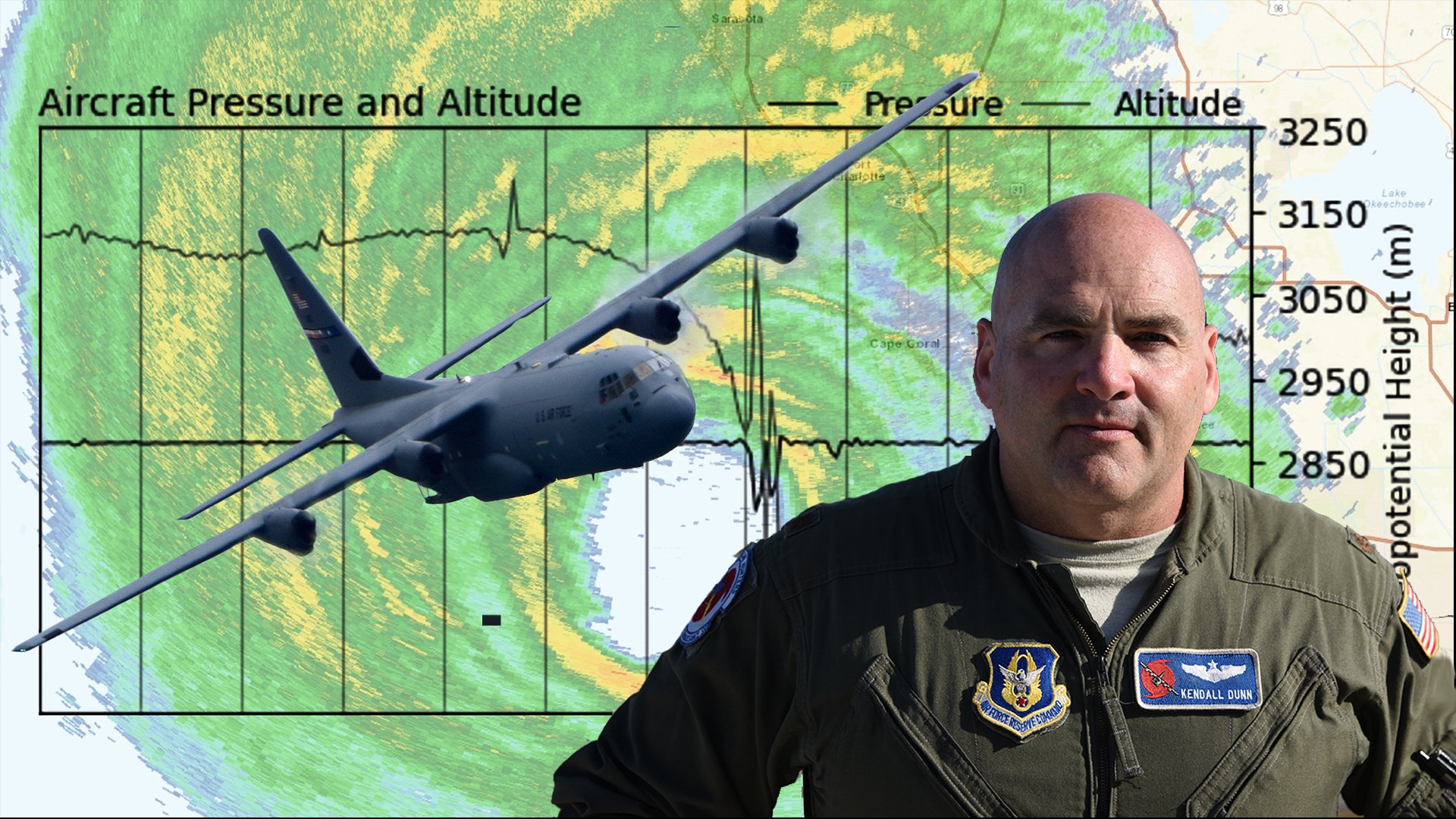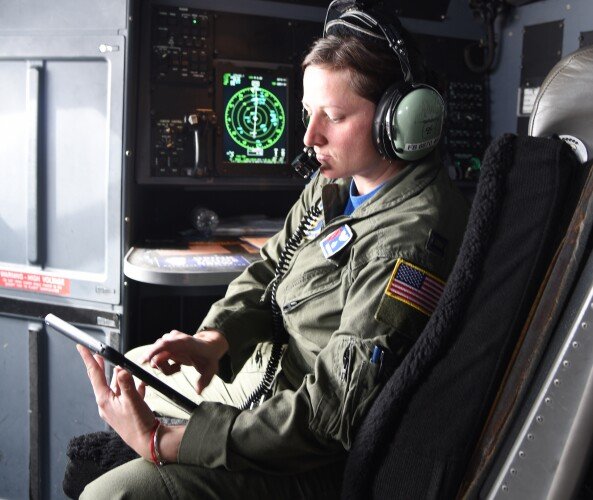‘The Worst Flight Ever’: Inside an Unforgettable Mission Into Hurricane Ian

With several nearly 1,000-foot swings up and down, Air Force Hurricane Hunter Teal 71 hit an epic patch of terrible turbulence inside Hurricane Ian. Chart from Tropical Tidbits. Composite by Kenna Lee/Coffee or Die Magazine.
Maj. Kendall Dunn knows something about taking big hits. Before he became a pilot for the Air Force Reserve's "Hurricane Hunters" in the 53rd Weather Reconnaissance Squadron, he played defensive line for the University of Southern Mississippi's football team. As a senior, he helped lead the squad to a major victory in the 1997 Liberty Bowl.
But he may never have taken a hit like the one Hurricane Ian laid on Dunn and the crew of his WC-130J during a Sept. 28 reconnaissance flight, just hours before the monster storm made landfall.
"It was by far my worst flight,” Dunn told Coffee or Die Magazine. “It was like one of those times when you’re a kid out playing, and as soon as you come through the door, your mom knows you almost just died just by looking at you. Like you almost got hit by a car or something."
Dunn was the aircraft commander Wednesday morning on a Hurricane Hunter flight that, according to data downloaded from the plane, may have taken one of the wildest rides ever recorded by the 53rd's legendary "Hurricane Hunters."

Maj. Kendall Dunn, 53rd Weather Reconnaissance Squadron pilot, in front of a WC-130J Super Hercules at Keesler Air Force Base, Mississippi, May 30, 2019. US Air Force photo by Tech. Sgt. Christopher Carranza.
According to flight data collected by the National Hurricane Center and first published by Tropical Tidbits, Dunn's WC-130J hit turbulence inside Ian that yo-yoed the 75,000-pound plane 3,500 feet in just over two minutes.
Flying under the call sign Teal 73 and tracked by the National Hurricane Center as AF301, the WC-130J exceeded its rated limits for G-forces inside the storm, Dunn said, temporarily grounding the plane when it returned to Keesler Air Force Base.
Just what, exactly, did it feel like on that flight? In terms of diving, climbing, and G-forces, the turbulence Dunn's flight hit was roughly as violent as four nonstop trips around the Kingda Ka roller coaster in New Jersey, which at 456 feet is the tallest and fastest coaster in North America.

The Kingda Ka roller coaster at Six Flags Great Adventure in Jackson, New Jersey, goes up and then back down 456 feet in 28 seconds. You would have to ride it five times in a row, nonstop, to simulate the up-and-down ride a Hurricane Hunter flight took through Hurricane Ian, according to National Hurricane Center data. Photo from Six Flags website.
“But we’re the ones driving the roller coaster,” Dunn said.
Teal 73 had been airborne for close to seven hours when it hit the extreme turbulence. Because most Hurricane Hunter flights are 10 or more hours, they fly with an additional pilot and navigator. The pilots on board along with Dunn were Maj. Forrest Heintz and Capt. Ben Smith. Heintz flies for United Airlines, and Smith for Delta, while Dunn is a full-time Air Force Reserve pilot. The navigators were Maj. Julie Fantaske and Capt. Micah Hudgins with Capt. Garrett Black on board as the plane’s weather officer. Tech. Sgt. Keith Taylor was the flight’s load master.
Teal 73 also carried researchers from a US Naval Academy research program and seven media members, some of whom, Dunn said, were making their first trip on a military flight.
“We had some vomit,” Dunn said.
Teal 73 hit the turbulence close to 8 a.m. Wednesday, as Ian was charging up to a near-Category 5 storm over warm Gulf of Mexico waters. With Dunn and Heintz at the controls, Teal 73 approached Ian in a gentle descent, dropping about 1,000 feet in 20 minutes, barely perceptible in a C-130.
At 8:05 a.m., the onboard data recorders reported that the plane rocketed upward at least 648 feet — roughly the height of the St. Louis Arch — in 30 seconds, followed immediately by a drop of nearly 1,200 feet in one minute.

Thirty seconds later, the plane had swooped back up another 655 feet, only to immediately dive 1,000 feet in the next minute.
Teal 73's up-down-up-down flight path covered roughly 3,500 vertical feet, and the plane's motion was probably more violent than even those numbers suggest. The flight data at the National Hurricane Center only reports the numbers every 30 seconds, meaning the plane likely moved even farther up and down between those pings.
"I'm a big ol' former football player," said Dunn. "People see me and they see a big, brazen dude with courage. But I was saying my prayers."
"But the thing with prayers is then you have to do something about them," he added.

Capt. Julie Fantaske, 53rd Weather Reconnaissance Squadron navigator in 2019. Fantaske was one of two navigators on board Teal 73. US Air Force photo by Tech. Sgt. Christopher Carranza.
As they broke through the eyewall, the plane likely hit a mesovortex, a small but very strong updraft formed just inside the eye of a hurricane. The upward swings, Dunn said, stunned the crew because Teal 73 seemed to be flying in a way that was impossible. As the blast hit Teal 73, the aircraft's nose pushed upward at 20 degrees and began to rise, but the plane also began accelerating — a normally impossible feat of physics without increasing throttle.
"When a guy is on the flight controls, he's the autopilot," said Dunn. "That person is making good corrections, hand on the controls, helping it go [the] right direction. You don't want to fight it trying to maintain a certain altitude and risk breaking the airplane."
A G-meter on board the plane recorded readings of 2.2 Gs during the massive climbs and a negative reading of minus 0.1 G during the dives. In other words, in a matter of seconds, those on board felt their bodies weigh twice the normal amount and then, as the plane dove back down, experienced a completely weightless moment. The WC-130J, said Dunn, is built to absorb 2.3 positive Gs — slightly more than Teal 73 encountered in Ian — but should not fly with negative Gs, which it did.
As a result, Dunn said he grounded the aircraft after landing until maintenance troops gave it a full inspection to ensure nothing had been broken. Though the plane was back on duty Thursday, Dunn said memories of the flight may last longer for those who were on board.
"When a crew gets off a flight and gives you a hug and tells you, 'I'm glad it was you,' well, that's really meaningful and you know it was bad," Dunn said.
Read Next: Who Makes the Army’s ‘Best Squad’? Soldiers From 12 Commands Compete This Week at Fort Bragg

Matt White is a former senior editor for Coffee or Die Magazine. He was a pararescueman in the Air Force and the Alaska Air National Guard for eight years and has more than a decade of experience in daily and magazine journalism.
BRCC and Bad Moon Print Press team up for an exclusive, limited-edition T-shirt design!
BRCC partners with Team Room Design for an exclusive T-shirt release!
Thirty Seconds Out has partnered with BRCC for an exclusive shirt design invoking the God of Winter.
Lucas O'Hara of Grizzly Forge has teamed up with BRCC for a badass, exclusive Shirt Club T-shirt design featuring his most popular knife and tiomahawk.
Coffee or Die sits down with one of the graphic designers behind Black Rifle Coffee's signature look and vibe.
Biden will award the Medal of Honor to a Vietnam War Army helicopter pilot who risked his life to save a reconnaissance team from almost certain death.
Ever wonder how much Jack Mandaville would f*ck sh*t up if he went back in time? The American Revolution didn't even see him coming.
A nearly 200-year-old West Point time capsule that at first appeared to yield little more than dust contains hidden treasure, the US Military Academy said.












